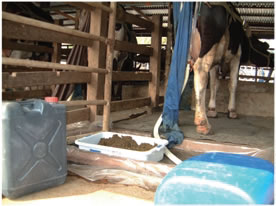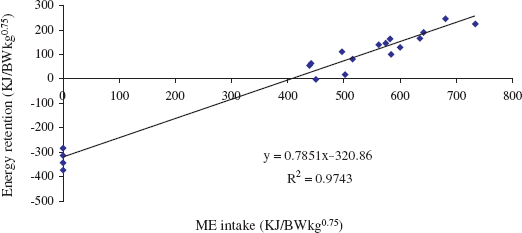Energy requirements for maintenance of Holstein crossbred dry cows in Northeast Thailand
Description
[Objectives]
Dairy farming in Northeast Thailand has been growing as an important agriculture sector. But it still faces numerous difficulties in the area of feeding management. Feeding strategies for dairy cattle are clearly described in the feeding standards for cattle in temperate countries, but they cannot be applied directly to the dairy cattle in Thailand because the specific breed of cattle, available feed and surrounding environment in the region are quite different from conditions elsewhere. The nutritional physiology of dairy cattle raised in Northeast Thailand has not yet been well characterized, so the present study aims to examine the effect of protein levels on energy and nitrogen balances in dairy dry cows.
Metabolism trials were conducted with four Holstein crossbred dry cows in order to examine the requirements for maintenance in dairy cows; each cow was fed Ruzi grass hay mixed with different levels of soybean meal. Crude protein (CP) contents in the four dietary treatments were 3.3, 6.4, 9.7 and 13.1%. The dietary treatments consisted of a nine-day preliminary period and a five-day collection period. After the last dietary treatment, the cows were fasted for 4 days. Feces and urine were collected from each animal during the collection period, and only urine was collected over the last two days of the fasting period (Photo 1). Oxygen consumption and the production of carbon dioxide and methane were measured with the ventilated flow-through method during the last 4 days of the feeding period and during the last 2 days of the fasting period.
[Results]
The metabolizable energy (ME) requirements for maintenance were calculated through a regression analysis of energy retention against ME intake on the basis of metabolic body size. The regression equation was estimated as Y=0.7851X-320.86, and the ME requirement for maintenance obtained was 409 KJ/BWkg0.75 (Fig. 1). This value for ME requirement was the highest compared to animals examined in previous studies, followed by Brahman cattle (377KJ/BWKg0.75), swamp buffalo (334KJ/BWkg0.75), and Thai native cattle (245KJ/BWkg0.75). It was 17 % lower than the value in the Holstein cattle (487KJ/BWkg0.75) as suggested in the feeding standards (Agriculture, Forestry and Fisheries Research Council Secretariat, 1999). Further studies are required to conclude values of ME requirement for the maintenance of Holstein crossbred cattle in Thailand; however, at present it is clear that heat and methane production of the Holstein crossbred cattle in the present studies were higher than those in animals from previous studies.
These result will serve as basic information for the establishment of feeding standards in Thailand.
Figure, table
-
Photo 1. Cows installed with harnesses to attach feces bags and urine tubes in order to separately collect feces and urine during the collection period. -
Fig. 1. Relationship between ME intake and energy retention in dairy dry cow.
- Affiliation
-
Japan International Research Center for Agricultural Sciences Animal Production and Grassland Division
-
NARO Institute of Livestock and Grassland Science
Khon Kaen Animal Nutrition Research and Development Center, Department of Livestock Development
- Classification
-
Technical A
- Term of research
-
FY2001 (FY1995-2001)
- Responsible researcher
-
ODAI Masaharu ( Animal Production and Grassland Division )
KAWASHIMA Tomoyuki ( NARO Institute of Livestock and Grassland Science )
PIMPAPORN Pholsen ( Khon Kaen Animal Nutrition Research and Development Center )
CHUENPREECHA Taweesak ( Khon Kaen Animal Nutrition Research and Development Center )
- ほか
- Publication, etc.
-
T. Kawashima, W. Sumamal, P. Pholsen, R. Chaithiang, W. Boonpakdee and F. Terada (2000): Comparative study on energy and protein metabolism of Brahman cattle and sheep given Ruzy grass hay with different levels of soybean meal. In: T. Kawashima (ed.) Improvement of cattle production with locally available feed resources in Northeast Thailand, JIRCAS and DLD, 123-136.
- Japanese PDF
-
2001_15_A3_ja.pdf748.98 KB
- English PDF
-
2001_12_A4_en.pdf79.55 KB


